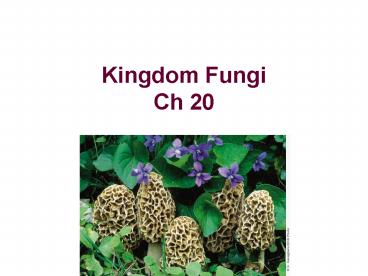Kingdom Fungi Ch 20 - PowerPoint PPT Presentation
1 / 30
Title:
Kingdom Fungi Ch 20
Description:
a) Rhizoid. Anchor the fungus in its food source. b) Stolon ... Other hyphae, rhizoids, anchor the fungus. Ex. Bread Mold (Rhizopus) ... – PowerPoint PPT presentation
Number of Views:487
Avg rating:3.0/5.0
Title: Kingdom Fungi Ch 20
1
Kingdom FungiCh 20
2
General Characteristics of Fungi
- Ubiquitous
- Decompose
- Some are parasitic, some are mutualistic
- Have plant animal characteristics
- PLANT many are anchored in the ground cell
walls (but NOT of cellulose) - ANIMAL Heterotrophic
- On the dead and on living
- What do we call these 2 groups?
3
Fungi General Characteristics
- Mostly multicellular
- A few are unicellular
- Most of life cycle is haploid
- They have a nucleus
- Many have multiple nuclei
- They have a cell wall
- Made of chitin
- Digestion is EXTRACELLULAR!
- They secrete an enzyme that breaks down nutrients
THEN they take them in - NO PHOTOSYNTHESIS!
4
FUNGI STRUCTURE
- Made of thin filaments hyphae (fuzzy)
- Hyphae can grow as individual cells or may fuse
together - there are different types of hyphae
- some for reproduction, some for growth, some for
stability (sturdy) - Hyphae that form a web and work together
Mycelium
5
6. Structure Hyphae Types/Functions
- a) Rhizoid
- Anchor the fungus in its food source
- b) Stolon
- Run along the surface of the food source
- Give rise to 2 mating forms ( and -)
- Sexual reproduction growth
- c) Sporangia
- Also called fruiting bodies
- Swell at the tips of sporangiophores
- Contain the spores used for
- asexual reproduction
6
What are the dots around the sporangium?
7
Hyphae
- All Fungi except for yeast are made of Hyphae
- Each Hypha is one cell, can have 1 or 2 nuclei
free to move or not - Body of Fungi is called Mycelium many hyphae
tangled together - Fruiting Body above ground reproductive part of
mycelium
8
More about their structure.
- The visible part of a fungus is only a very small
part of the mycelium.
.most is underground
9
(No Transcript)
10
Worlds Largest OrganismArmillaria ostoyae
- Covers 8.9km2 6.5 tons of biomass
- 2,400 years old
- Strawberry Mountain. Oregon
11
FUNGI ADAPTATIONS
- Extracellular (external) digestion followed by
absorption - Some can be parasitic
12
FUNGI REPRODUCTION
- Some reproduce asexually, some sexually
- Asexual reproduction
- Fragmentation/budding,
- Spores!
- Spores can be thick walled resist water loss
- (ie, the fungus won't dry out)
- Sexual reproduction
- hyphae fusion
- haploid haploid diploid
13
Reproduction Summary
14
Asexual Reproduction in Action
- Spores are being released into the air!
15
Reproduction Summary
16
Reproduction
- Sexual Reproduction
- 2 different mating types () and (-)
- Hyphae of opposite mating types meet
- Each Hypha forms a Gametangium
- Structure that makes gametes (haploid)
- 2 haploid gametes fuse make diploid zygote
- Meiosis takes place to make haploid org
17
Classification of Fungi
- Classify by structure and reproduction methods
- All have different types of hyphae
- 1. Phylum Zygomycota Common Molds
- Ex Bread Mold
- 2. Phylum Ascomycota Sac Fungi
- Cup Fungi, Yeasts
- 3. Phylum Basidiomycota Club Fungi
- Mushrooms
- 4. Phylum Deuteromycota Imperfect Fungi
- Catch all Ex Penicillium
18
Zygomycetes
- Zygote fungi
- Reproduce sexually asexually
- Formed from 2 different gametangium that fuse
- 2 Gametangium zygospore
- -Other hyphae, rhizoids, anchor the fungus
- Ex. Bread Mold (Rhizopus)
19
Life Cycle of Phylum Zygomycota
20
Ascomycetes
- Sac fungi
- Reproduce sexually asexually
- Spores (called ascospores) are made in a sac is
called an ascus - Conidiophores form and help disperse haploid
spores - Important fermenters
- Convert sugar to CO2 alcohol
- Ex. Yeasts (with no hyphae), powdery mildews,
food molds
21
Ascomycetes Life Cycle
22
Basidiomycetes
- Club fungi
- Reproduce sexually asexually
- Forms a club shaped structure Basidia this is
where spores are made Basidiospore - Cap where reproduction takes place
- Ex. Mushrooms, puffballs, smuts
23
Phylum BasidiomycotaLife Cycle
24
Deuteromycetes
- Imperfect Fungi
- Reproduce asexually only
- Typical Molds
- Penicillin
25
MUTUALISTIC FUNGI
- 2 types
- a) Lichens
- b) Mycorrhizae
26
- a) Lichens
- SYMBIOSIS of a fungus (usually an ascomycetes)
with an algae OR a cyanobacteria
- The fungal partner benefits by getting sugars,
its only nutrients, from the algae which
photosynthesize. - The algal partner gets protection as the fungi
normally forms the outer surface.
27
- b) Mycorrhizae
- Fungus Plant
- Hyphae grow on
- roots of plant
- How does each benefit?
28
(No Transcript)
29
Ecology of Fungi
- Fungi are heterotrophic decomposers
- Saprobes fungi that obtain food by breaking
down dead and decaying orgs - Can be decomposers good for nutrient cycle
- Need this to maintain life!
- Can be predators
- Some fungi poison and decompose worms which feed
on them
30
Ecology Cont.
- Disease Some Fungi are Pathogenic
- Plant diseases Rusts, Root Rot
- Animal diseases
- Ringworm, Yeast infections, Athletes Foot































